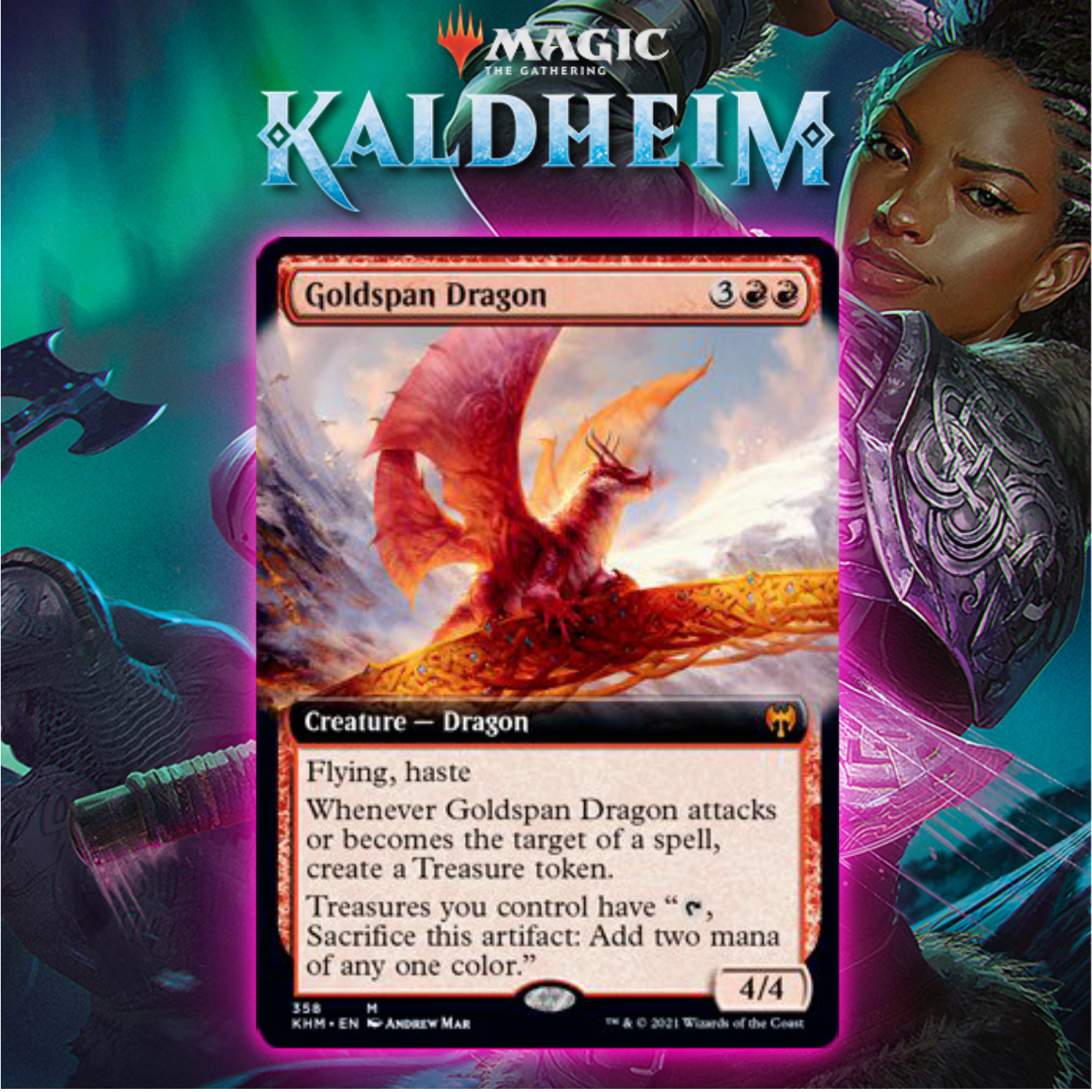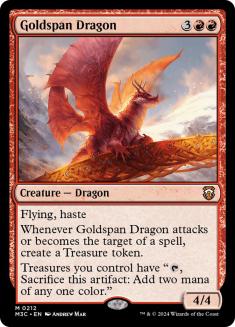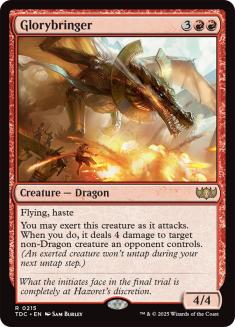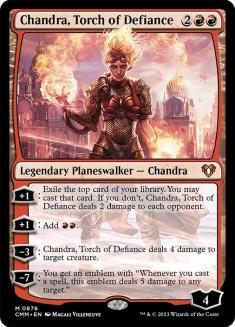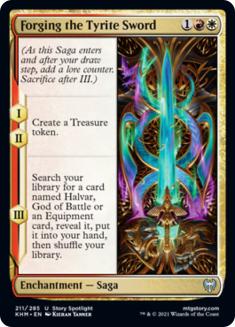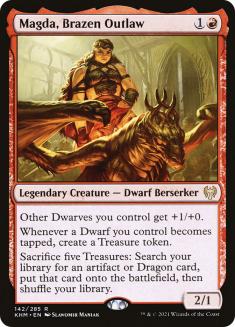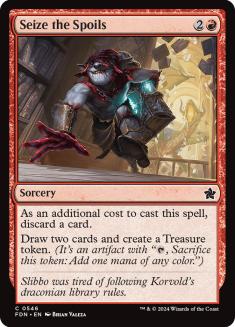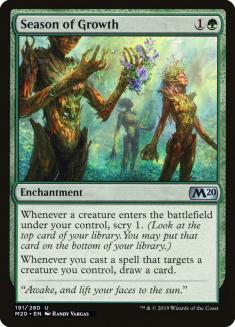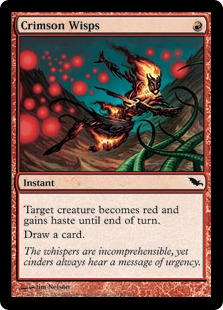There are a lot of layers to Goldspan Dragon (which is fitting for a Dragon so rich it might need multiple lairs).
At face value, we have a Glorybringer that makes Treasures instead of being able to exert. That’s probably a little weaker in a vacuum, but Glorybringer is a pretty high bar, so that’s not too bad. But is making Treasures — doubled Treasures — actually worse than Glorybringer’s ability?
In some ways, this comparison reminds me of two ways to use Chandra, Torch of Defiance. You can use the -3, kill a creature, and have a card that’s mostly spent, or you can +1 to get mana, cast a removal spell, and have a planeswalker that’s all set to do whatever on the following turn. Attacking with Goldspan Dragon and using the Treasure to cast a removal spell is like using Chandra to cast a removal spell; you end up with a powerful Dragon that’s ready to attack again the following turn.
If that were the full story, this would be a landslide for Glorybringer, but there’s a lot more to Goldspan Dragon. Glorybringer’s ability is only as good as the best creature it can kill, while Goldspan Dragon’s ability is what you make of it. If we’re just getting two mana back when we attack, we can kind of squint at this and see a three-mana 4/4 flying haste Dragon. Great for a double-spell turn to pull way ahead, but that’s just the beginning.
When I imagine getting two mana after casting a Dragon, the first thing I want to do with that mana is protect the Dragon, but given that this makes a Treasure when my opponent tries to kill it, I don’t even have to factor that into my plans. I cast this and go to attack. My opponent doesn’t want me to get the Treasure for attacking, so they try to kill it. I make a Treasure because it was targeted, use that Treasure to cast something like a Negate or Gods Willing, save my Dragon, attack, and make another Treasure.
You don’t even need to hold mana to protect this with spells that cost one or two; that much is free. In fact, if I protect it with a Gods Willing or similar, I actually make another Treasure for targeting it myself, and then another when I attack. Now I’ve made three Treasures the turn I cast this, and spent one of the six mana those Treasures could generate, so I could still hypothetically spend five more mana this turn.
It’s easy to start to see how this five-mana Dragon with a two-mana rebate is actually so much more than that. So how do we make the most of it?
Level 1: Ramp
The most “on the surface” thing you can do with this Dragon is just use it to cast big stuff.
We’ve seen the Irencrag Feat / Ugin, the Spirit Dragon decks, and as far as cards I have to play to enable Ugin, I have to say this Dragon does a lot more by itself than Irencrag Feat. If you cast this and your opponent doesn’t kill it, after you’ve attacked the turn after you cast it, you’ve made two Treasures that each give you two mana. If you add that to the five your lands could already produce to cast this, you’re looking at nine mana at least without even hitting your next land, which is to say you have more than enough mana to cast Ugin. Sound a little Magical Christmas Land™? I hope not — we’re literally just talking about untapping with your five-mana creature once. I agree that you’re often in good shape when that happens, but it’s certainly not a stretch; that kind of thing happens regularly.
Okay, maybe you don’t trust that you can untap with it. Consider this: if your opponent is tapped out, you know you’re getting one Treasure when you attack. If they untap and target the Dragon to kill it, you get another Treasure. That’s two Treasures and five lands. You play your sixth land, and now you can cast Ugin. This card really does make it easy.
Goldspan Dragon is also just a great fit in this style of deck, which is basically just a bunch of cheap removal, so if you’re behind, you can cast Goldspan Dragon, attack, and “build your own Glorybringer” by using the Treasure to cast a removal spell. If you want a deck that’s ready to go right now, just slot this into Big Red and call it a day.
Creatures (12)
Planeswalkers (4)
Lands (20)
Spells (24)

What about Temur Adventures w/ Obosh? Those Treasures certainly make the burden of finding all the right mana for Genesis Ultimatum a lot easier, and if you’re playing blue, you can get some Negates in your deck to protect your Dragon, and you can ramp so much with the Dragon that you can easily cast Genesis Ultimatum with Negate backup on Turn 5 with a pretty average draw: Turn 3 Cultivate; Turn 4 Goldspan Dragon; Turn 5 attack again, make a second Treasure, and then you can Ultimatum with Negate up even if you missed your land drop that turn.
Level 2: Interaction
Okay, maybe you don’t want to play such a clunky deck. Maybe you want your five-mana Dragon to be the top of your curve. No problem. This is an awesome finisher in an Izzet deck with some countermagic, Bonecrusher Giant, and Brazen Borrower. You get some nice threats that fill your deck with two-mana interaction so you can get all the tempo advantage Glorybringer would offer with the added benefit that your opponent can’t even kill it before you attack because the Treasure you make will just let you counter their removal spell.
If you’re not too married to the idea that the Dragon has to be the top of your curve, maybe I can interest you in a little Sublime Epiphany for spice? It’s pretty nice to copy this Dragon and the Treasures do make the mana a lot easier.
Creatures (16)
Lands (17)
Spells (27)

Level 3: Treasure Synergy
Maybe you want to go a little further to take advantage of everything Goldspan Dragon can do for you. If you have Treasures before you play Goldspan Dragon, this might actually net you mana the turn you cast it. How easy is it to get a few Treasures on the battlefield before Turn 5?
Well, it’s definitely possible.
What are we doing with all that mana? Well, we could just cast Ugin or Genesis Ultimatum, but personally, if I’m filling my deck with cards that make Treasure tokens, I love the idea of playing Korvold, Fae-Cursed King. It might feel tough to play a lot of five-cost Dragons, but remember, it’s strictly easier than trying to use a five-cost Dragon to ramp into a seven- or eight-mana spell, and if we’re making Treasures with our cheaper cards, it won’t be hard to get to five mana.
It’s hard to know just how deep the Treasure theme will go. Gilded Assault Cart suggests that we’ll probably see more “Treasure Matters” cards, or at least a few more cards that make Treasures, so Goldspan Dragon could easily end up functioning as a “Treasure Lord.”
It looks like Treasure and Dwarves will be linked Boros things in Kaldheim, so maybe Magda will make us want to play Koll, the Forgemaster as another Dwarf, which will make us want equipment, and Forging the Tyrite Sword will tie the room together with Goldspan Dragon and we’ll end up with some weird midrange Treasure/Equipment deck with a few big payoffs. It’s hard to imagine exactly where that ends up or what the curve looks like, but there could be something there.
Level 4: Combo
My first thought when I read Goldspan Dragon was that I get mana when I attack or when my opponent tries to kill it, but there’s no clause on Goldspan Dragon that limits creating a Treasure to an opponent targeting it. If you target it with a spell, you make two mana. That means it can make an unbounded amount of mana. Defiant Strike becomes a one-mana Manamorphose. There aren’t a lot of cards like that in Standard, but this scales up really quickly as you go to older formats.
In Historic, you get Season of Growth, so maybe we’ll see this with Feather, the Redeemed.
In Modern, you can add cards like Crimson Wisps, which allows you to have a lot of copies of this effect, but you also get Shimmering Wings, which gives you an infinite loop that may not get you anywhere on its own but does generate infinite storm count, constellation triggers, artifact entering the battlefield triggers, sacrifice triggers, or whatever else you might be looking for. Will this give new meaning to the term “Dragon Storm” in Modern? Unlikely, but not technically impossible, I suppose. (I’d be shocked if such a deck is competitive.)
In older formats (read: Commander), you can actually play several cards like Shimmering Wings: Crown of Flames, Flickering Ward, and Whip Silk if, for some reason, you want to really lean into this combo.
Level 4 might be too deep. You probably just want to focus on killing your opponent with your Dragon rather than pretending it’s some wacky five-mana combo piece.
Realistically, I think we’ll be seeing Goldspan Dragon in ramp decks, which will usually be red or Temur and may or may not have a larger Treasure theme; Izzet midrange decks; Korvold decks (maybe); and possibly in midrange Gruul or Boros decks, where it can pair with cards like Gods Willing, Ranger’s Guile, or Heroic Intervention.
So realistically, we’re using these Treasures to either cast bigger spells or protect our Goldspan Dragon, and the decks that are looking to protect Goldspan Dragon probably want some kind of mana sink for all the Treasures they’ll end up with, but shouldn’t go too far out of their way for it. Boros remains the wildcard here. I’m not sure about Forging the Tyrite Sword, but using it to cast Goldspan Dragon on Turn 4 and then attacking and casting another four-mana spell in the second main phase doesn’t sound horrible.
With such a high power level that fits in so many directions, Goldspan Dragon seems like a safe call as a mythic that will see some play in Standard and beyond.

